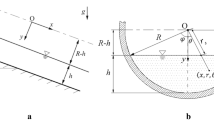Abstract
An experimental investigation of the transition of a laminar flow regime into a turbulent one has been carried out in [1] for a flow in a circular pipe which is organized due to injection through the porous lateral surface with a jammed leading end of the pipe. It was established as a result that injection leads to an increase in stability of the laminar flow regime and increases the Reynolds number of the transition to 10,000 instead of the value 2300 which is characteristic of flow in a circular pipe with impenetrable walls. A similar effect was discovered in [2], in which it was also obtained that the Reynolds number of stability loss under the action of injection can take values significantly larger than in pipes with impenetrable walls. The phenomenon of relaminarization of a turbulent flow in the initial section of a circular pipe under the action of injection has been experimentally detected at the entrance for relatively low Reynolds numbers in [3, 4]. Theoretical investigations of stability of flow with injection have been performed only for a plane channel [5, 6]. A calculation is made in this paper of the stability of a hydrodynamically developed flow in a circular pipe with injection through a porous lateral surface.
Similar content being viewed by others
Literature cited
K. Huesmann and E. R. G. Eckert, “Investigations of a laminar flow and the transition to turbulence in porous pipes with symmetric injection through the pipe wall,” Wörme und Stoffubertragung,1, No. 1 (1968).
V. I. Yagodkin, “The use of channels with porous walls for the investigation of intrachannel combustion of solid rocket fuels,” in: Transactions of the 18th International Astronautical Congress [in Russian], Belgrade (1967).
E. R. G. Eckert and W. Rodi, “Reverse transition for turbulent-laminar flow through a tube with fluid injection,” J. App. Mech.,35, No. 4 (1968).
W. T. Pennel, E. R. G. Eckert, and E. M. Sparrow, “Laminarization of turbulent pipe flow by fluid injection,” J. Fluid Mech.,52, No. 3 (1972).
V. N. Varapaev and V. I. Yagodkin, “The stability of the flow in a channel with penetrable walls,” Izv. Akad. Nauk SSSR, Mekh. Zhidk. Gaza, No. 5 (1969).
V. N. Varapaev, N. A. Kuril'skaya, et al., “The stability of non-self-similar flows in channels with penetrable walls,” Tr. MISI, No. 102 (1973).
F. C. T. Shen, T. S. Chen, and L. M. Huang, “The effects of mainflow radial velocity on the stability of developing laminar pipe flow,” J. Appl. Mech.,43, No. 2 (1976).
R. M. Terrill and P. W. Thomas, “On laminar flow through a uniformly porous pipe,” Appl. Scient. Res.,21, No. 1 (1969).
M. A. Gol'dshtik and V. N. Shtern, Hydrodynamic Stability and Turbulence [in Russian], Nauka, Novosibirsk (1977).
V. M. Eroshenko, L. I. Zaichik, and V. B. Rabovskii, “The stability of a plane flow near a leading critical point with strong injection,” Izv. Akad. Nauk SSSR, Mekh. Zhidk. Gaza, No. 2 (1982).
Author information
Authors and Affiliations
Additional information
Translated from Zhurnal Prikladnoi Mekhaniki i Tekhnicheskoi Fiziki, No. 3, pp. 82–86, May–June, 1984.
Rights and permissions
About this article
Cite this article
Eroshenko, V.M., Zaichik, L.I. & Rabovskii, V.B. Calculation of the stability of the flow in a circular pipe with injection. J Appl Mech Tech Phys 25, 408–411 (1984). https://doi.org/10.1007/BF00910403
Received:
Issue Date:
DOI: https://doi.org/10.1007/BF00910403




